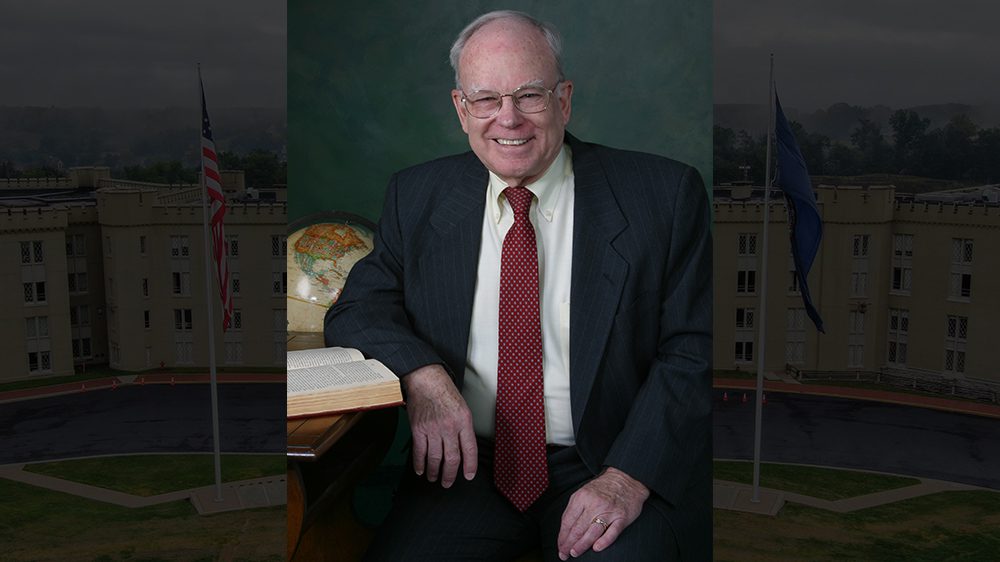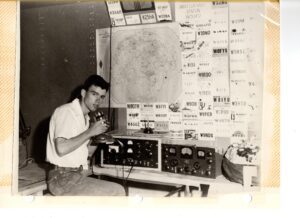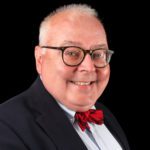Payne ’58: VMI Sent the Signal

John Payne '58 says being the recipient of a scholarship is what inspired him to give back to the Institute.—Photos courtesy John B. Payne III ’58.

John Payne '58 says being the recipient of a scholarship is what inspired him to give back to the Institute.—Photos courtesy John B. Payne III ’58.
An extraordinary event happened at VMI in spring 1958: A cadet—John B. Payne III ’58—was the guest of honor at a VMI parade. He received this high honor as a reward for winning a regional research competition sponsored by the American Institute of Electrical Engineers and held at Duke University against 21 other schools. At the parade, he also received an award from the Armed Forces Communications and Electronics Association.
But that’s not the most interesting part of an extraordinary story of pioneering work in electronics and decades of entrepreneurship.
Oddly, a career in electronics began in a woodworking class in junior high school. Payne was 14 when he took the class because he had been held back in school twice. The reason: He was challenged by dyslexia and so had trouble reading, writing, and memorizing information. His troubles with dyslexia did not extend to other aspects of learning, however. “I always had a very strong interest in mechanical, electrical things, and math,” he explained.
Payne’s performance in woodworking apparently impressed his teacher because he was invited to join a group learning about electricity and electronics. “The first thing taught was Ohm’s Law, the most basic thing in electronics,” which “describes the relationship between current, voltage, and resistance,” according to the Encyclopaedia Britannica. After the teacher demonstrated the concept, “I was fascinated and grasped the idea quickly.”
As a young high school student, Payne learned how radios work, how to read a schematic, and how to build a radio receiver. “These concepts live with me to this day, and they allowed me to accelerate my learning in later years,” he said.
While in high school in Arlington Heights, Texas, Payne began building his own ham radio equipment and won local science fairs by demonstrating it by talking to other “hams” all over the world. His achievement was more impressive because his school did not offer classes in electronics.
During a visit to a local diner, he noticed people congregating at a nearby filling station. Curious, he introduced himself and learned they were there because it was a good place to listen to police and fire calls on specially built radios.
Learning that Payne built ham radio equipment, they asked if he could create a receiver that would let them listen to police cars and fire engines as well as calls in neighboring communities. It was then the entrepreneurial bug bit. “I was not one to pass up an opportunity to fund my ham equipment,” he explained.
With help from technicians at the local police and fire radio service center, Payne started work by modifying war surplus radio equipment and changing crystals’ frequency by applying sulfuric acid. Payne returned with the prototype, and someone bought it for $50 (about $525 in 2022).
Next, he built and installed devices that allowed car radios to pick up emergency calls. After selling a few to the people at the filling station, Payne offered them for sale through a newspaper ad, charging $20 each.

Payne as a teenager with the ham radio equipment he built himself.
As a high school senior, Payne’s attention shifted from his business to his future as an electronics engineer. “By going to school, I would learn the theory behind the electronic circuits I dabbled with.”
His father, a 1921 graduate of VMI who studied civil engineering and received the First Jackson-Hope Medal, suggested VMI. His father’s tales of barracks life had been reinforced by his mother, who told him of his father’s academic success at VMI.
The family connection appealed to Payne, and as he applied for colleges, he was daunted by the prospect of filling out lengthy application forms and writing the required essays. “Dyslexia limited me when it came to English [and] writing.”
As his father helped Payne with the applications process, he told him more about his experiences at VMI and how “his education there had proved a big advantage in the workplace and life in general.” Whatever he said must have been persuasive because, in early September 1954, Payne began the two-day train trip to Lexington.
Payne’s experience related to radios and electronics stood him in good stead as an electrical engineering major. “With the basic theory I was learning, everything was falling into place.” He also did well in mathematics, chemistry, and mechanical drawing.
Yet, his dyslexia made the study of history and English difficult, and it also created difficulties in the Rat Line, as he had trouble remembering material from the Rat Bible and even other cadets’ names. He flunked his second semester of English, after which VMI asked that he pass the course that summer at another school in order to return. He took the course at TCU. “I don’t know how I passed, but I did—and that was all that mattered.”
Payne pressed on—wearing academic stars his last two years—and he was rewarded for his perseverance during his 1st Class year. At the time, the electrical engineering department required its cadets submit a research project, either a full-length paper or a shorter paper and piece of hardware. Knowing his dyslexia would hinder writing a full-length paper, he took the latter option.
At first, Payne was concerned he might not be able to get the parts he needed to create his senior research project. He went to Col. John S. Jamison Jr., Class of 1926, department head, who, along with Col. Lee J. Nichols Jr. ’44, directed him to a “cubbyhole in the lower part of Nichols Engineering Hall,” where there were surplus parts and equipment that might suit him. They also agreed to buy a new volt/ohm meter and lend him an oscilloscope.
Payne’s project—a simplified telemetry system—consisted of a transmitter-receiver pair. “It enabled me to input variable analog data to the transmitter, which sent them by a wireless radio signal to the receiver from which the data was extracted.”
Designing and building the devices demanded much of Payne’s time. “I spent many hours, days, and nights in the lab and so missed out on many activities.” Indeed, his history in the Bomb states, he “always managed to find those extra minutes to spend on his electrical monster in the E.E. lab.”
Those sacrifices bore fruit in terms of winning the research competition and giving him the confidence to pursue graduate study. During his 1st Class year, he saw an announcement of a scholarship sponsored by the Hughes Aircraft Company, a major aviation company that was a pioneer in electronics. Recipients would receive the funds to enroll in the University of Southern California’s master’s degree program in electrical engineering and work part-time at Hughes.
Excited by the idea of working for such a company while he received an advanced degree, Payne applied and submitted a request for an educational deferment from the Air Force. In mid-May, he was accepted—one of only 25 nationally—to the program, and the Air Force approved his educational deferment. With a path to the electronics industry ahead of him, Payne remembered thinking, “I am well on my way.”
“Colonel Jamison helped me get the Hughes Scholarship—which started my career—based on the strong recommendation he gave me. He was, therefore, a significant part of my success, and I’ve always felt I owed him something. So, when VMI asked for a donation, I felt this was appropriate.”
John B. Payne III ’58, on founding the Jamison-Payne Institute Professorship in Electrical Engineering
Starting at Hughes in July 1958, Payne worked with senior engineers on major projects, such as developing the search radar for the B-58 bomber. He also designed a power supply system to regulate the electricity generated by the solar panels of a geosynchronous communications satellite—that system later flew into space.
In 1960, Payne graduated from USC and began pursuing his Ph.D. at Pennsylvania State University. There, he conceived a method for measuring electron resonance in crystal materials, work which was the basis of his doctoral dissertation.
In 1963, he reported for duty with the Air Force, working as a project officer at the then-Rome Air Development Center in Rome, New York. There, he specialized in phased-array antenna systems and signal processing as they related to radar. Payne describes this work as “quite satisfying.” He wrote extensively and traveled nationally and internationally to present his work and served on Department of Defense and NATO committees. The Air Force recognized his work with an award in 1964.
In 1968, after being a civilian scientist at RADC for a year, he moved to the private sector. He saw an opportunity in the company Engelmann Microwave, where he established a separate division. “It was a time when microwave technology was moving into widespread practical application.”
“Five years after joining Engelmann, I became aware of a product that needed development, which Engelmann was not interested in pursuing.” Specifically, it was a microwave-phased locked signal source, which are used to communicate between satellites and ground stations as well as the point-to-point transmission of television, voice, and data over long distances. Payne developed this on his own in his basement. Soon, the same entrepreneurial spirit led him to strike out on his own when he left Engelmann and established Communications Techniques, Inc. As the sole supplier of such equipment, CTI grew rapidly.
Five years later, basing its product line on the technologies he developed in his basement, CTI soon had clients in the United States as well as Canada, India, and Europe. However, Payne needed to grow the company, and in order to do, he so hocked his house and anything else of value.
The gamble paid off, and CTI was soon an industry leader. In 1987, Payne sold the company to Dover Corporation, a Fortune 500 company led by Dick Bernstein ’65. Payne continued at the company for another three years before he retired. The company was making $15-$20 million in annual sales.

Payne played a major role in the development of technology such as this Nucomm 7 Series portable transmitter, used for broadcasting live events.
By “retiring,” Payne did not kick back and relax. He already had his eyes on a company—NURAD—a CTI customer that built aircraft antennas and radio equipment for the television industry. He purchased NURAD’s radio division and renamed it Nucomm, Inc.
Under Payne’s leadership, Nucomm became a leading manufacturer of equipment related to electronic newsgathering. Electronic newsgathering, according to Payne, “is what allows outdoor events, such as golf matches, the New York and Boston marathons, and NASCAR, to send live television to the viewing public.” The same equipment allows television stations to send live programming from TV studios to TV transmitters. Nucomm’s equipment was used extensively in the United States and around the world. One of the proudest moments for Payne was when its equipment was used to provide live coverage of the opening ceremonies and all outdoor events at the 2008 Summer Olympics in Beijing.
In 2007, with Nucomm enjoying annual sales of $100 million, Payne again decided to sell his company. As he did with CTI, he worked for another three years and then retired.
Like many longtime entrepreneurs, he proved an utter failure at retirement. He soon began options trading on the New York Stock Exchange, an activity that soon turned quite serious. In a couple of years, he founded Mallard Investment LLC, through which he invests some of the income he realizes through options trading in startup companies.
As busy as he has been and continues to be, Payne has maintained close ties to VMI. “I go back to VMI religiously,” he says, “albeit primarily to see my daughter, Mary Beth, who is married to Colonel Mac Baker of the electrical engineering department, and their children.” He has attended his class reunions faithfully, and he has applied his technical and business experience to the Institute’s betterment by serving on the boards of VMI Research Labs and the VMI Foundation, the former from 2003-09.
He also has been a generous donor to the Institute. In 1987, he established the Jamison-Payne Institute Professorship in Electrical Engineering. Asked why it was important to him to support VMI in this way, Payne replied, “Colonel Jamison helped me get the Hughes Scholarship—which started my career—based on the strong recommendation he gave me. He was, therefore, a significant part of my success, and I’ve always felt I owed him something. So, when VMI asked for a donation, I felt this was appropriate.”
According to Col. James C. Squire, Ph.D., who has held the professorship since 2018, the funds enable him to provide critical support to cadet-led research projects. These include a robotics project in 2021, which helped Eric Munro ’21, the project’s leader, secure a Bill and Melinda Gates Scholarship to Cambridge University. “Complex projects require iterative design methods, so the support I receive from the Jamison-Payne Professorship is absolutely critical to my research advisees’ successes.”
Support from the professorship has also advanced Squire’s professional development. “I typically consult during the summers, but with the funding, I have not needed to do so. Instead, I wrote my first textbook, co-authored with Lieutenant Colonel Julie Brown [Ph.D.] of the department of English, rhetoric, and humanistic studies, for those learning the computer language MATLAB.”
It is often said that where your treasure is, so too is your heart. So, it speaks much about Payne’s devotion to VMI when he pointed out that, while he appreciated what Penn State and USC provided him in the way of education, “I only give to VMI.”

The communications officer supports the strategy for all communications, including web content, public relations messages and collateral pieces in order to articulate and promote the mission of the VMI Alumni Agencies and promote philanthropy among varied constituencies.